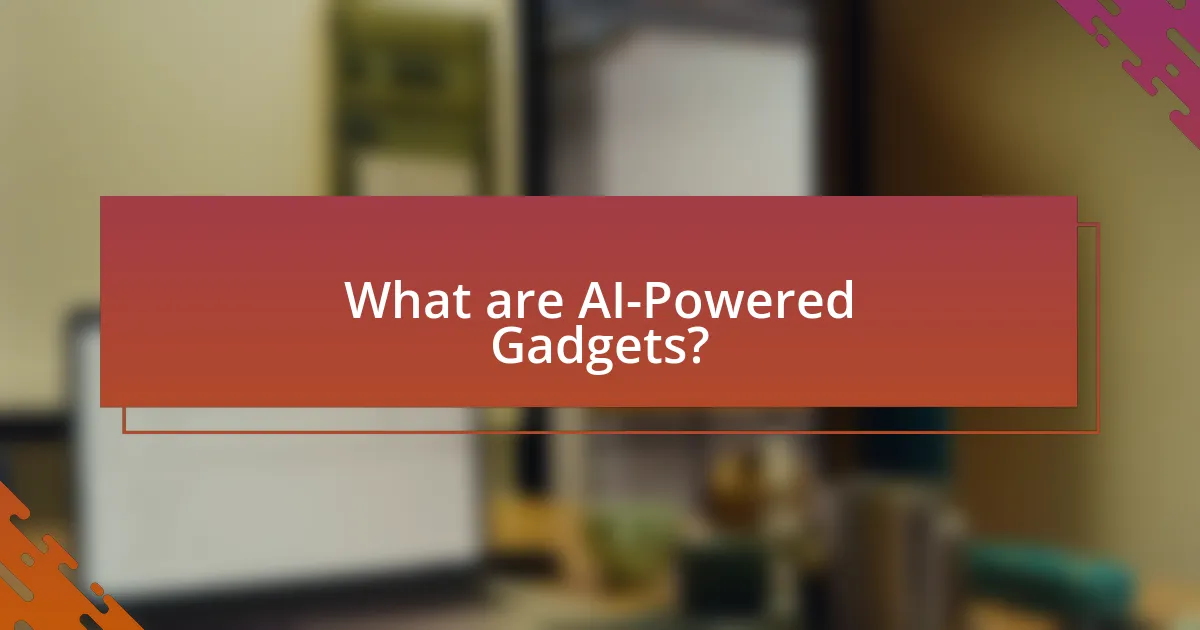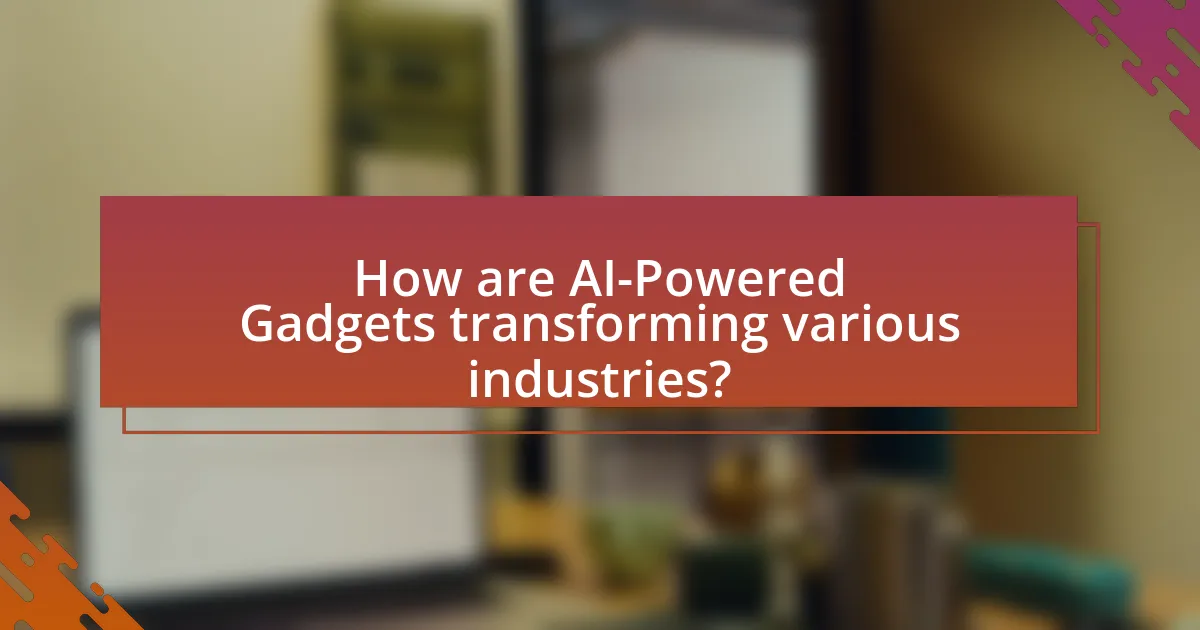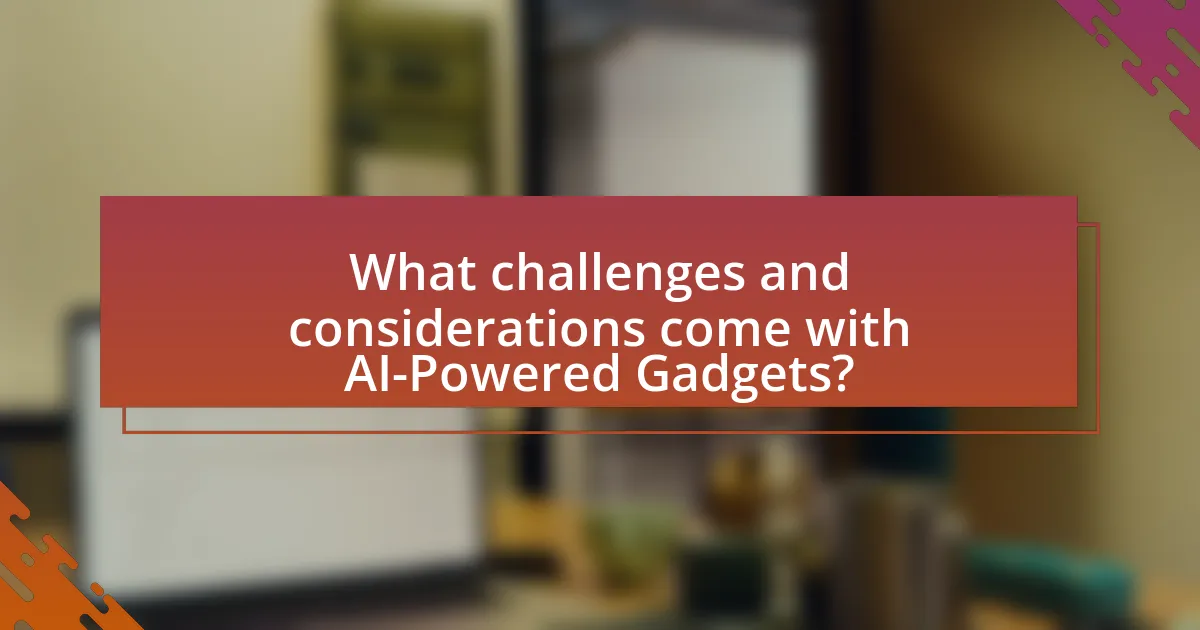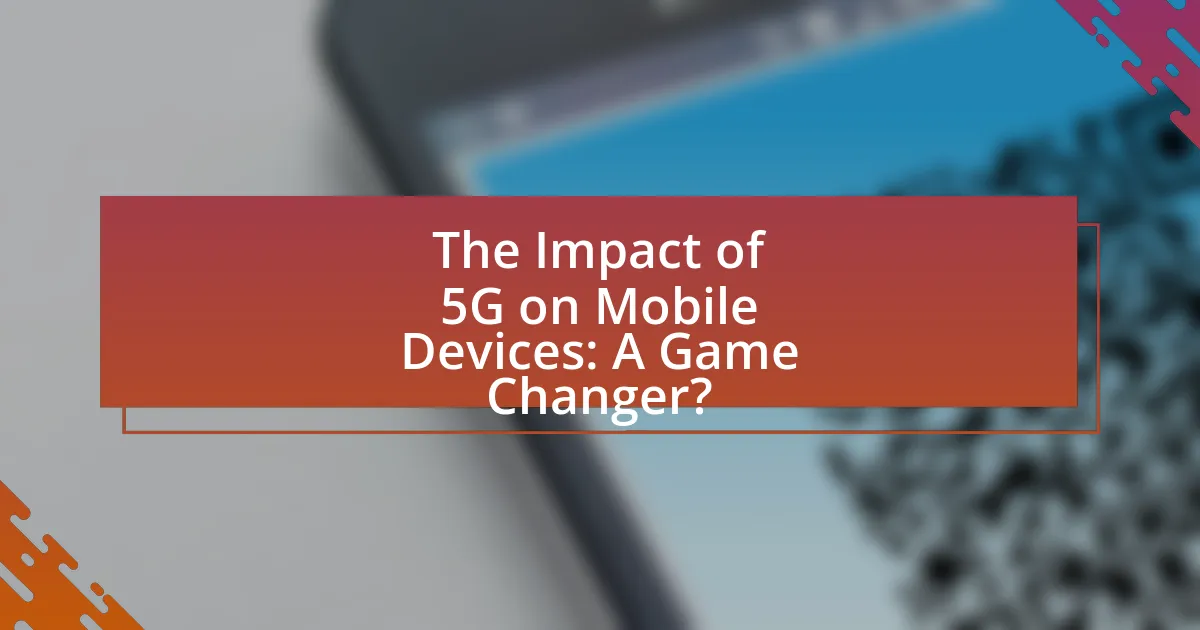AI-powered gadgets are devices that leverage artificial intelligence technologies to enhance functionality and user experience, performing tasks such as voice recognition and predictive analytics. This article explores how these gadgets, including smart speakers, wearable fitness trackers, and smart home devices, are integrated into daily life, improving efficiency and convenience. It discusses the technologies enabling AI, the impact on various industries, and the benefits for personal health and productivity. Additionally, the article addresses challenges such as privacy concerns and data security, while providing best practices for users to maximize the benefits of these innovative devices.

What are AI-Powered Gadgets?
AI-powered gadgets are devices that utilize artificial intelligence technologies to enhance their functionality and user experience. These gadgets can perform tasks such as voice recognition, image processing, and predictive analytics, allowing them to adapt to user preferences and behaviors. For instance, smart speakers like Amazon Echo use AI to understand voice commands and provide personalized responses, demonstrating the practical application of AI in everyday devices. The integration of AI in gadgets has been shown to improve efficiency and convenience, as evidenced by the growing market for smart home devices, which is projected to reach $174 billion by 2025, according to a report by Statista.
How do AI-Powered Gadgets function in our daily lives?
AI-powered gadgets function in our daily lives by utilizing machine learning algorithms and data analytics to perform tasks that enhance convenience and efficiency. These devices, such as smart speakers, wearable fitness trackers, and home automation systems, analyze user behavior and preferences to provide personalized experiences. For instance, smart thermostats learn a household’s temperature preferences over time, optimizing energy usage and comfort. According to a report by Statista, the global smart home market is projected to reach $174 billion by 2025, indicating a significant adoption of AI technologies in everyday devices. This integration of AI allows for seamless interactions and improved functionality, ultimately transforming how individuals manage their daily routines.
What technologies enable AI in these gadgets?
Technologies that enable AI in gadgets include machine learning algorithms, natural language processing, computer vision, and edge computing. Machine learning algorithms allow devices to learn from data and improve their performance over time, while natural language processing enables them to understand and respond to human language. Computer vision technology allows gadgets to interpret and analyze visual information, enhancing their functionality. Edge computing facilitates real-time data processing on the device itself, reducing latency and improving efficiency. These technologies collectively empower AI-driven features in gadgets, making them more intelligent and responsive to user needs.
How do machine learning and data processing contribute to their functionality?
Machine learning and data processing enhance the functionality of AI-powered gadgets by enabling them to learn from data and make informed decisions. Machine learning algorithms analyze vast amounts of data to identify patterns and improve performance over time, allowing gadgets to adapt to user preferences and behaviors. For instance, smart home devices utilize machine learning to optimize energy consumption based on usage patterns, leading to increased efficiency. Data processing facilitates the extraction of meaningful insights from raw data, ensuring that AI systems can operate effectively and respond accurately to real-time inputs. This synergy between machine learning and data processing is crucial for the intelligent operation of devices, as evidenced by the rapid advancements in personal assistants and smart appliances that continuously improve their functionality through user interaction and data analysis.
What types of AI-Powered Gadgets are available today?
AI-powered gadgets available today include smart speakers, smart home devices, wearable fitness trackers, robotic vacuum cleaners, and AI-enabled cameras. Smart speakers like Amazon Echo and Google Nest use voice recognition to assist users with tasks. Smart home devices, such as thermostats and lighting systems, utilize AI for energy efficiency and automation. Wearable fitness trackers, like Fitbit and Apple Watch, analyze health data to provide personalized insights. Robotic vacuum cleaners, such as Roomba, employ AI for navigation and cleaning efficiency. AI-enabled cameras, including those used in security systems, leverage facial recognition and motion detection for enhanced safety. These gadgets exemplify the integration of AI into everyday life, improving convenience and functionality.
Which categories of gadgets are most popular among consumers?
Smartphones, laptops, and smart home devices are the most popular categories of gadgets among consumers. According to a report by Statista, as of 2023, smartphone penetration reached 78% globally, while laptops accounted for 60% of personal computing devices. Additionally, the smart home market is projected to grow significantly, with an estimated 1.4 billion smart home devices expected to be in use by 2025, indicating a strong consumer preference for these gadgets.
How do smart home devices differ from wearable technology?
Smart home devices differ from wearable technology primarily in their function and location of use. Smart home devices are designed to automate and control home environments, such as smart thermostats, lights, and security systems, typically installed in fixed locations within a home. In contrast, wearable technology, such as smartwatches and fitness trackers, is designed for personal use and mobility, allowing users to monitor health metrics and receive notifications on the go. This distinction highlights that smart home devices focus on enhancing home automation and security, while wearable technology emphasizes personal health and connectivity.
What impact do AI-Powered Gadgets have on daily routines?
AI-powered gadgets significantly enhance daily routines by automating tasks, improving efficiency, and providing personalized experiences. For instance, smart home devices like thermostats and lighting systems adjust settings based on user preferences and habits, leading to energy savings and increased comfort. Research from McKinsey indicates that automation can boost productivity by up to 30%, demonstrating the tangible benefits of integrating AI into everyday life. Additionally, AI-driven personal assistants streamline scheduling and information retrieval, allowing users to manage their time more effectively. This integration of AI technology into daily routines not only simplifies tasks but also fosters a more connected and efficient lifestyle.
How do these gadgets enhance productivity and efficiency?
AI-powered gadgets enhance productivity and efficiency by automating repetitive tasks and providing real-time data analysis. For instance, smart assistants can schedule meetings, manage emails, and set reminders, allowing users to focus on higher-priority tasks. Additionally, AI-driven analytics tools can process large datasets quickly, enabling informed decision-making and reducing the time spent on data interpretation. According to a study by McKinsey, organizations that implement AI technologies can increase productivity by up to 40%, demonstrating the significant impact these gadgets have on operational efficiency.
In what ways do they improve personal health and wellness?
AI-powered gadgets improve personal health and wellness by providing personalized health monitoring, enhancing fitness tracking, and facilitating mental well-being. These devices, such as smartwatches and fitness trackers, continuously monitor vital signs like heart rate and sleep patterns, allowing users to gain insights into their health status. For instance, a study published in the Journal of Medical Internet Research found that wearable devices can significantly increase physical activity levels among users, leading to improved cardiovascular health. Additionally, AI-driven applications offer tailored workout plans and nutritional advice, which can lead to better lifestyle choices. Furthermore, mental health apps utilize AI to provide personalized mindfulness exercises and stress management techniques, contributing to overall emotional well-being.

How are AI-Powered Gadgets transforming various industries?
AI-powered gadgets are transforming various industries by enhancing efficiency, automating processes, and improving decision-making. In healthcare, for instance, AI devices analyze patient data to provide personalized treatment plans, leading to better patient outcomes. In manufacturing, AI-powered robots optimize production lines, reducing downtime and increasing output by up to 20%. Retail industries utilize AI for inventory management and customer service, resulting in a 30% increase in customer satisfaction. These advancements illustrate how AI gadgets are revolutionizing operational capabilities across sectors.
What sectors are most influenced by the rise of AI-Powered Gadgets?
The sectors most influenced by the rise of AI-Powered Gadgets include healthcare, automotive, consumer electronics, and manufacturing. In healthcare, AI gadgets enhance diagnostics and patient monitoring, leading to improved outcomes; for example, AI algorithms can analyze medical images with accuracy comparable to human radiologists. In the automotive sector, AI-powered devices facilitate advancements in autonomous driving and safety features, significantly impacting vehicle design and functionality. Consumer electronics have seen a surge in smart devices, such as voice assistants and smart home systems, which streamline daily tasks and improve user experience. Lastly, in manufacturing, AI gadgets optimize production processes through predictive maintenance and automation, resulting in increased efficiency and reduced costs.
How is the healthcare industry benefiting from AI technology?
The healthcare industry is benefiting from AI technology through improved diagnostics, personalized treatment plans, and enhanced operational efficiency. AI algorithms analyze vast amounts of medical data, enabling faster and more accurate disease detection, such as identifying tumors in radiology images with up to 94% accuracy, as demonstrated in studies published in journals like Nature. Additionally, AI-driven tools assist in creating tailored treatment strategies based on individual patient data, leading to better health outcomes. Furthermore, AI optimizes administrative tasks, reducing costs and streamlining processes, which allows healthcare professionals to focus more on patient care.
What role do AI gadgets play in the education sector?
AI gadgets play a transformative role in the education sector by enhancing personalized learning experiences and improving administrative efficiency. These devices, such as intelligent tutoring systems and AI-driven learning platforms, adapt to individual student needs, providing tailored educational content and feedback. For instance, a study by the Bill & Melinda Gates Foundation found that personalized learning approaches, often facilitated by AI technologies, can lead to significant improvements in student performance, with some students showing up to a 30% increase in learning outcomes. Additionally, AI gadgets streamline administrative tasks, allowing educators to focus more on teaching rather than paperwork, thereby increasing overall productivity in educational institutions.
How do businesses leverage AI-Powered Gadgets for growth?
Businesses leverage AI-powered gadgets for growth by enhancing operational efficiency, improving customer engagement, and enabling data-driven decision-making. For instance, smart devices like IoT sensors streamline supply chain management by providing real-time data on inventory levels, which can reduce costs and optimize resource allocation. Additionally, AI-powered customer service tools, such as chatbots, enhance customer interactions by providing instant support, leading to increased customer satisfaction and retention. According to a report by McKinsey, companies that adopt AI technologies can increase their cash flow by 20% or more, demonstrating the significant impact of these gadgets on business growth.
What advantages do companies gain from integrating these gadgets?
Companies gain several advantages from integrating AI-powered gadgets, including enhanced efficiency, improved decision-making, and increased customer engagement. These gadgets automate routine tasks, allowing employees to focus on higher-value activities, which can lead to productivity gains of up to 40%, as reported by McKinsey. Additionally, AI-powered analytics provide insights that enable companies to make data-driven decisions, improving operational effectiveness and reducing costs. Furthermore, these gadgets facilitate personalized customer interactions, leading to higher satisfaction rates and loyalty, as evidenced by a study from Salesforce indicating that 70% of consumers expect personalized experiences.
How do AI gadgets enhance customer experience and engagement?
AI gadgets enhance customer experience and engagement by providing personalized interactions and efficient service. These devices utilize machine learning algorithms to analyze user data, enabling them to tailor recommendations and responses to individual preferences. For instance, smart assistants like Amazon’s Alexa or Google Assistant can learn a user’s habits and suggest products or services that align with their interests, leading to increased satisfaction and loyalty. Additionally, AI-powered chatbots offer 24/7 customer support, resolving inquiries quickly and effectively, which significantly improves user engagement. According to a report by Gartner, by 2022, 70% of customer interactions will involve emerging technologies like AI, highlighting the growing reliance on these gadgets to enhance customer experiences.

What challenges and considerations come with AI-Powered Gadgets?
AI-powered gadgets face several challenges and considerations, including privacy concerns, security vulnerabilities, and ethical implications. Privacy concerns arise as these devices often collect and process personal data, leading to potential misuse or unauthorized access. Security vulnerabilities are significant, as AI gadgets can be targets for cyberattacks, which can compromise user data and device functionality. Ethical implications include the potential for bias in AI algorithms, which can lead to unfair treatment of users based on race, gender, or socioeconomic status. According to a report by the Pew Research Center, 81% of Americans feel that the potential risks of data collection by smart devices outweigh the benefits, highlighting the widespread concern regarding privacy and security in the context of AI-powered gadgets.
What privacy concerns are associated with AI-Powered Gadgets?
AI-powered gadgets raise significant privacy concerns primarily due to their ability to collect, store, and analyze vast amounts of personal data. These devices often require continuous internet connectivity and utilize sensors and cameras to gather information about users’ behaviors, preferences, and environments. For instance, smart speakers and home assistants can record conversations, leading to potential unauthorized access to sensitive information. According to a 2021 report by the Electronic Frontier Foundation, many AI gadgets lack robust security measures, making them vulnerable to hacking and data breaches. Furthermore, the data collected can be sold to third parties without user consent, exacerbating privacy risks.
How do data security issues affect user trust in these devices?
Data security issues significantly undermine user trust in AI-powered devices. When users perceive that their personal data may be compromised, they become hesitant to adopt or continue using these technologies. For instance, a 2021 survey by Pew Research Center found that 81% of Americans feel that the potential risks of data collection by companies outweigh the benefits. This statistic illustrates that concerns over data breaches and unauthorized access directly correlate with diminished confidence in the devices. Furthermore, high-profile incidents, such as the 2017 Equifax data breach, which exposed sensitive information of approximately 147 million people, serve as concrete examples of how security failures can lead to widespread distrust in technology.
What regulations are in place to protect consumers?
Consumer protection regulations include laws such as the Consumer Product Safety Act, the Fair Credit Reporting Act, and the Federal Trade Commission Act. These regulations are designed to ensure that products are safe, that consumers have access to accurate information, and that unfair or deceptive practices are prohibited. For instance, the Consumer Product Safety Act mandates that products meet safety standards to prevent harm, while the Fair Credit Reporting Act protects consumers’ credit information and ensures accuracy in reporting. The Federal Trade Commission Act empowers the FTC to prevent unfair or deceptive acts affecting commerce, thereby safeguarding consumer interests.
How can users maximize the benefits of AI-Powered Gadgets?
Users can maximize the benefits of AI-powered gadgets by actively engaging with their features and customizing settings to suit personal preferences. By exploring the full range of functionalities, such as voice commands, automation, and integration with other smart devices, users can enhance efficiency and convenience in daily tasks. For instance, studies show that households utilizing smart home devices experience a 30% reduction in energy consumption due to optimized usage patterns. Additionally, regularly updating software ensures access to the latest features and security improvements, further enhancing the user experience.
What best practices should users follow for optimal performance?
Users should regularly update their AI-powered gadgets to ensure optimal performance. Keeping software and firmware up to date enhances security, fixes bugs, and improves functionality, which is crucial for devices that rely on AI algorithms. For instance, a study by the Cybersecurity & Infrastructure Security Agency (CISA) indicates that 85% of vulnerabilities can be mitigated through timely updates. Additionally, users should optimize device settings based on their specific needs, as personalized configurations can significantly enhance efficiency and user experience.
How can users troubleshoot common issues with AI gadgets?
Users can troubleshoot common issues with AI gadgets by following a systematic approach that includes restarting the device, checking for software updates, and ensuring proper connectivity. Restarting often resolves temporary glitches, while software updates can fix bugs and improve functionality. Additionally, verifying that the device is connected to the internet or paired correctly with other devices is crucial, as many AI gadgets rely on stable connections to operate effectively. According to a study by the Consumer Technology Association, 70% of tech-related issues can be resolved through these basic troubleshooting steps, highlighting their effectiveness in addressing common problems.



